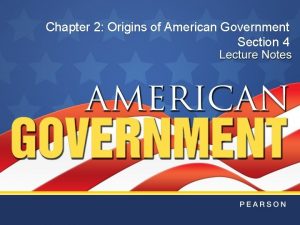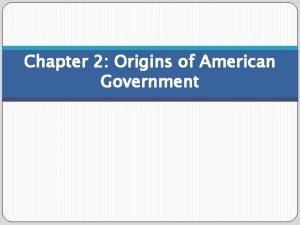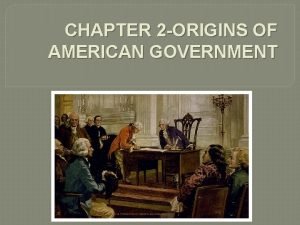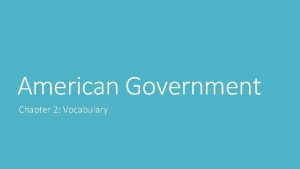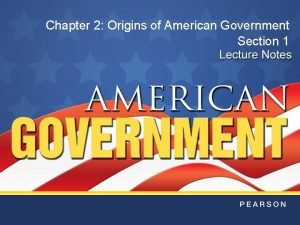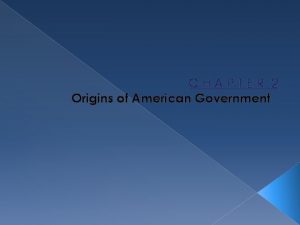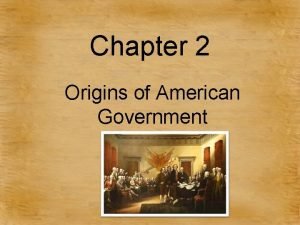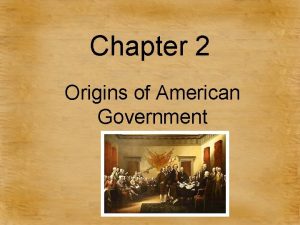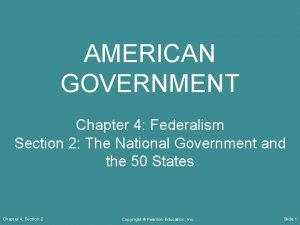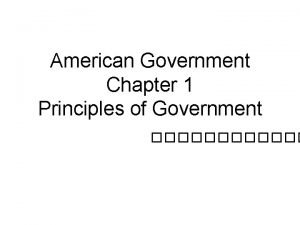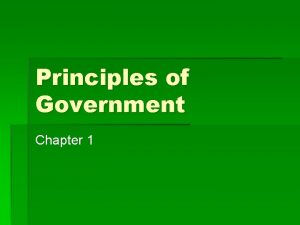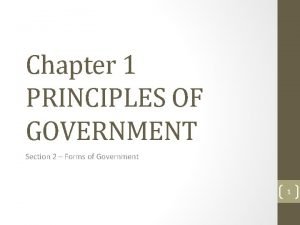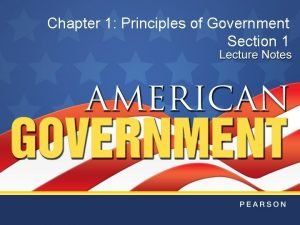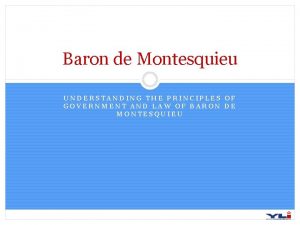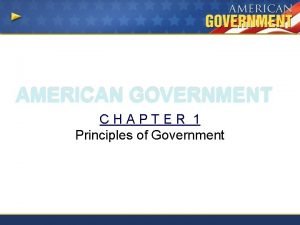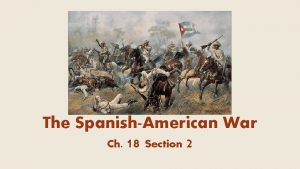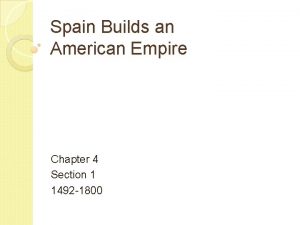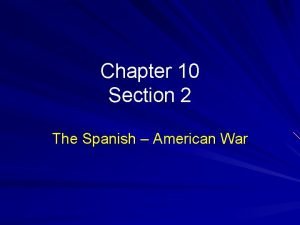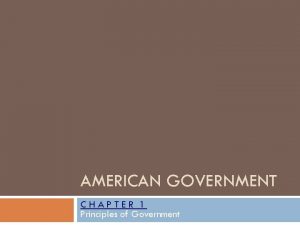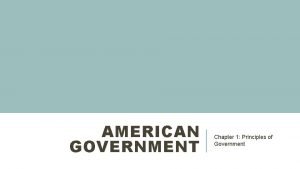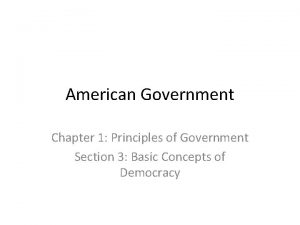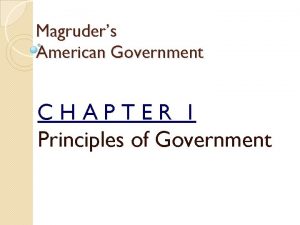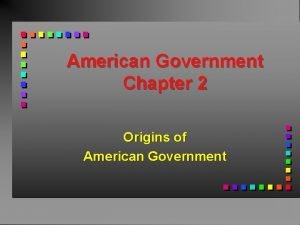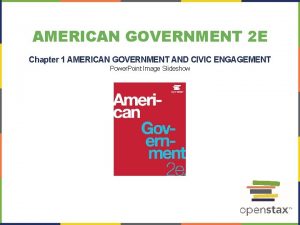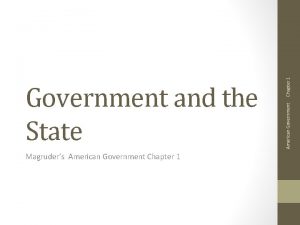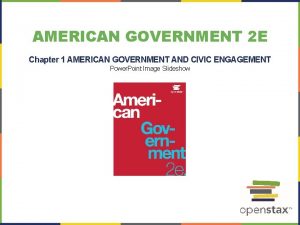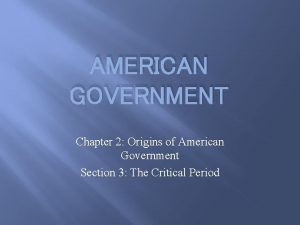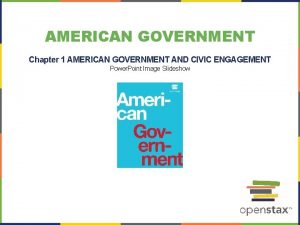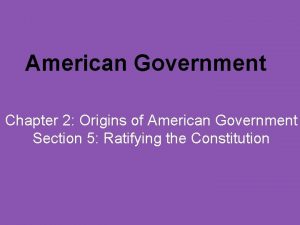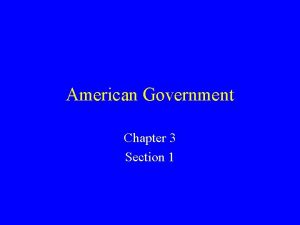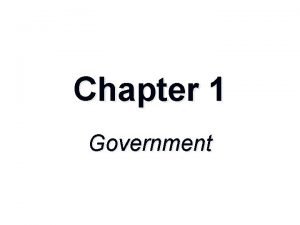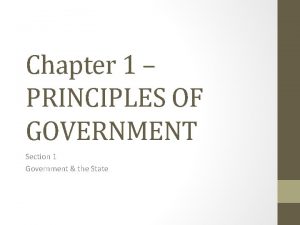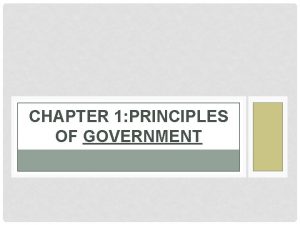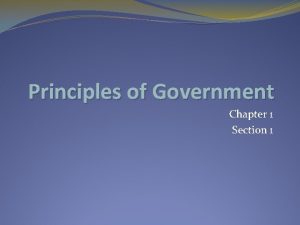American Government Chapter 1 Principles of Government Section






















- Slides: 22

American Government Chapter 1 Principles of Government ������

Section 1: Government and the State • The BIG Idea: • A government enables a society to carry out its policies and protect its citizens from violence and injustice

What is Government? • Government- the institution through which a society makes and enforces its public policies. Government is made up of those people who exercise its powers, all those who have authority and control the people. • The public policies of a government are all the things a government decides to do. • Every government has and exercises three basic kinds of power: 1) legislative power—the power to make law 2) executive power– the power to execute, enforce, and administer law…and 3) judicial power– the power to interpret laws, to determine their meaning, and to settle disputes that arise within the society. • A constitution is the body of fundamental laws setting out the principles, structures, and processes of a government.

The State • The state can be defined as a body of people, living in a defined territory, organized politically, and with the power to make and enforce law without consent of any higher authority. • The state has emerged as the dominant political unit in the world. • In popular usage, a state is often called a “nation” or a “country” • 4 Characteristics of a State: • 1) population-must have people, but the size may vary • 2) territory—land with known and recognized boundaries • 3) sovereign—it has supreme and absolute power within its own territory • 4) government—politically organized in some way

Major Political Ideas: • 1) The Force Theory-some believe that the state is born through force…. might makes right…. . force a group to submit to your rule • 2) The Evolutionary Theory-the state developed out of the early families who took control • 3) The Divine Right Theory-God created the state and God has given those of royal birth a “divine right” to rule • 4) The Social Contract Theory-theory argues that the state arose out of a voluntary act of free people…. it holds that the state exists only to serve the will of the people, the people are the source of power, and that they are free give the power as they choose.

Theories of Power 1) Force! (Authority comes from fear/ violence) -Dictatorships -Fascism -Oligarchy

Theories of Power 2) Divine Right (Authority comes from God) -Monarchies -Feudalism -Theocracy

Theories of Power 3) The People (Authority comes from the consent of the governed) -Democracy -Socialism • Magna Carta – British document declaring that others, beside the king, have political power • Social Contract – The People and the Government must be responsive to each other

3 Powers of All Governments • Create Laws (Legislative) – Make rules • Enforce Laws (Executive) – Make sure the rules are followed • Interpret Laws (Judicial) – Explain the rules • Politics is the process by which government is established/changed

What Do All Governments Do? • Organize & Coordinate • Keep the Peace • Provide Common Defense – Protect from external & internal threats • Do What They Think Is Best for “The People”

Who Are Your Governments? • Federal (National) – U. S. President – Supreme Court – Congress • State – Governor, State Legislature, Supreme Court • Local – County Board, City Council, School Board – State and federal have jurisdiction

What Does Your Government Do? • Positive* – – – – Keep us Safe Educate Make Laws Organize our Country Delivers mail Employs many people Welfare • Negative* – – – – Taxes Educate Give tickets “The Man” “Invades” privacy Employs many people Welfare

Government State population territory Purpose Powers legislative judicial executive sovereignty Preamble

Section 2: Forms of Government • The BIG Idea • The United States is a democracy with a federal and presidential system of government

Classifying Governments • No two governments are, or ever have been, exactly alike, for governments are the products of human needs and experiences. • Three classifications of government: • 1) who can participate in the government • 2) the geographic distribution of governmental power within the state • 3) the relationship between the legislative and the executive branches of the government

Who Can Participate • To many people, the most meaningful of the classifications is the one that depends on the number of persons who can take part in the governing process. • Democracy: supreme authority rests with the people. A democracy can be either direct or indirect. A Direct Democracy is where the people direct government themselves…. this no longer exists in a national form anywhere in the world…. the New England town meeting is still an example. An Indirect Democracy is representative democracy…. . what we are used to in the US…. in either form, the people are the source of governmental power. • Dictatorship: exists where those who rule cannot be held responsible to the will of the people…. the government is not held accountable for their actions…. an autocracy is a governement in which a single person holds unlimited power…. . an oligarchy is a government in which the power to rule is held by a small group.

Geographic Distribution of Power • A Unitary Government is often described as a centralized government…. all powers belong to a single, central agency…. the central government then creates local units of government for its own convenience. • A Federal Government is one in which the powers of the central government are divided between a central government and several local governments…. sometimes referred to as division of powers…. . the U. S. is a great example • A Confederation is an alliance of independent states… the central government has the power to handle only those matters that the member state have assigned to it…. defense and foreign affairs (most of the time)

Relationship Between Legislative and Executive Branches: • This grouping yields two forms of government: • 1) Presidential Government- features a separation of powers between the executive and the legislative branches of government…the two branches are separate and coequal • 2) Parliamentary Government- the executive is made up of the prime minister and the that official’s cabinet…the prime minister and the cabinet themselves are members of the legislative branch, the parliament…the executive is thus chosen by the legislature and is subject to its direct control

Classifications of Government Who may participate in government? *Democracy *Dictatorship Where is the power held? *Unitary *Federal *Confederation What is the relationship between the legislative and executive branches? *Presidential *Parliamentary

Section 3: Basic Concepts of Democracy • The BIG Idea: • Democracy rests on the rights and freedoms of individuals; the American commitment to these ideals is evident in its free enterprise system

Notions of American Democracy • Each individual has worth • All individuals are equal • The majority should rule but must respect minority rights • Compromise is necessary • Each individual must have the widest possible degree of freedom • The nation’s free enterprise economy reinforces the belief in individual freedom

Democracy and the Free Enterprise System • The American economic system is often called the free enterprise system. It is an economic system characterized by the private ownership of capital goods, investments made by private decision, and success or failure determined by competition in the market • This system works through supply and demand. • An economy in which private enterprise exits in combination with a considerable amount of government regulation and promotion is called a mixed economy.
 Origins of american government section 4
Origins of american government section 4 Origins of american government section 1
Origins of american government section 1 Origins of american government section 1
Origins of american government section 1 Chapter 2 american government
Chapter 2 american government Chapter 2 origins of american government vocabulary
Chapter 2 origins of american government vocabulary Chapter 2 origins of american government answer key
Chapter 2 origins of american government answer key Chapter 2 origins of american government worksheet answers
Chapter 2 origins of american government worksheet answers Chapter 2 lesson 1 origins of american government
Chapter 2 lesson 1 origins of american government Chapter 2 origins of american government
Chapter 2 origins of american government Chapter 4 federalism answer key
Chapter 4 federalism answer key Principles of government chapter 1 answers
Principles of government chapter 1 answers Principles of government chapter 1
Principles of government chapter 1 Chapter 1 principles of government
Chapter 1 principles of government Chapter 1 principles of government
Chapter 1 principles of government Chapter 1 principles of government
Chapter 1 principles of government Chapter 1 principles of government study guide answer key
Chapter 1 principles of government study guide answer key Chapter 1 principles of government
Chapter 1 principles of government The spanish american war chapter 18 section 2
The spanish american war chapter 18 section 2 Latin american peoples win independence chapter 8 section 1
Latin american peoples win independence chapter 8 section 1 Chapter 6 section 4 the american revolution
Chapter 6 section 4 the american revolution Spain builds an american empire chapter 20 section 1
Spain builds an american empire chapter 20 section 1 Chapter 10 section 2 the spanish american war answer key
Chapter 10 section 2 the spanish american war answer key Chapter 6 section 4 the american revolution
Chapter 6 section 4 the american revolution
